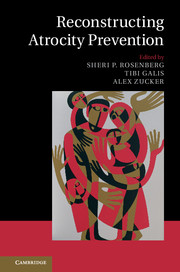Book contents
- Reconstructing Atrocity Prevention
- Reconstructing Atrocity Prevention
- Copyright page
- Dedication
- Contents
- Foreword
- Contributors
- Introduction
- Part I Fluidities
- 1 What Is Being Prevented? Genocide, Mass Atrocity, and Conceptual Ambiguity in the Anti-Atrocity Movement
- 2 The Pistol on the Wall: How Coercive Military Intervention Limits Atrocity Prevention Policies
- 3 Operationalizing the “Atrocity Prevention Lens”: Making Prevention a Living Reality
- 4 The “Narrow but Deep Approach” to Implementing the Responsibility to Protect: Reassessing the Focus on International Crimes
- 5 The Role of Social Psychology in Preventing Group-Selective Mass Atrocities
- 6 Gender, Sexualized Violence, and the Prevention of Genocide
- Part II Above Chronology
- Part III Acting Out Prevention
- Index
- References
5 - The Role of Social Psychology in Preventing Group-Selective Mass Atrocities
from Part I - Fluidities
Published online by Cambridge University Press: 05 September 2015
- Reconstructing Atrocity Prevention
- Reconstructing Atrocity Prevention
- Copyright page
- Dedication
- Contents
- Foreword
- Contributors
- Introduction
- Part I Fluidities
- 1 What Is Being Prevented? Genocide, Mass Atrocity, and Conceptual Ambiguity in the Anti-Atrocity Movement
- 2 The Pistol on the Wall: How Coercive Military Intervention Limits Atrocity Prevention Policies
- 3 Operationalizing the “Atrocity Prevention Lens”: Making Prevention a Living Reality
- 4 The “Narrow but Deep Approach” to Implementing the Responsibility to Protect: Reassessing the Focus on International Crimes
- 5 The Role of Social Psychology in Preventing Group-Selective Mass Atrocities
- 6 Gender, Sexualized Violence, and the Prevention of Genocide
- Part II Above Chronology
- Part III Acting Out Prevention
- Index
- References
- Type
- Chapter
- Information
- Reconstructing Atrocity Prevention , pp. 95 - 124Publisher: Cambridge University PressPrint publication year: 2015
References
- 14
- Cited by



